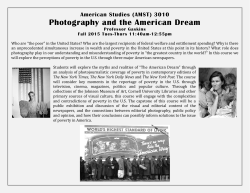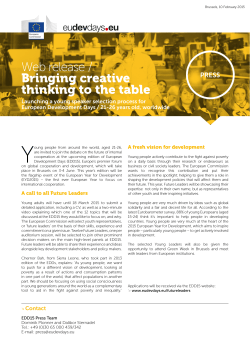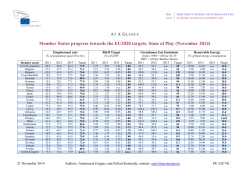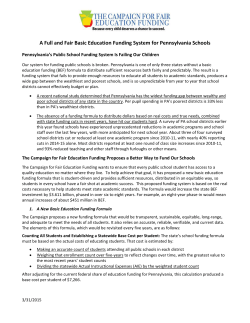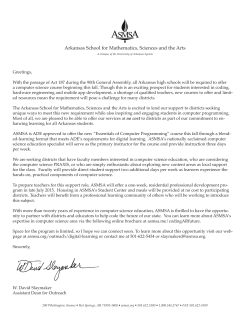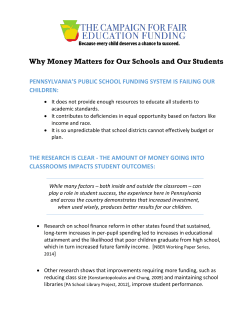
New York Should Address the Major Reason Schools
The State of New York “IS” Failing Schools: New York Should Address the Major Reason Schools “Fail” - Child Poverty March 17, 2014 The state can improve low-performing schools and help students who face learning barriers by increasing funding for key education programs and poverty-fighting efforts. Proposals by the governor and the legislature are a start, but still fall short of what is needed. In a report issued in February, the state identified 178 schools in 17 school districts as “priority” or “failing” schools.1 These schools score in the bottom 5 percent in student proficiency tests or have low graduation rates, or both. The school districts that are home to these priority schools teach students who face many challenges. • They live in communities that are among the poorest in the state with the least resources to improve local schools. Three times as many school age children live in poverty in districts with priority schools than in other New York school districts. • Over three-fourths of the students in priority schools are eligible for the federal free or reduced price lunch program. • Many of these students are not proficient in English or are from minority families with disproportionately high levels of unemployment and poverty. More than 9 out of 10 students in these schools are minorities. Students who grow up poor do less well in school than those from more advantaged households, a considerable body of research shows. To assist students in these low-performing schools, New York should address these barriers to achievement by: • Increasing K-12 school aid: Make a serious down payment on meeting the commitments of the settlement of the Campaign for Fiscal Equity case, in which the state’s school funding system was ruled unconstitutional. The state should increase aid by $2.2 billion and distribute it through the foundation formula – which provides aid based on student need – to ensure funds are targeted to high-needs school districts with high child poverty rates. • Increasing funding for universal Pre-Kindergarten. Provide additional funding to expand support for Pre-Kindergarten in upstate areas and assist New York City in meeting its goal to provide universal service in 2015-2016. 1 State of New York’s Failing Schools 2015 Report, Office of Governor Andrew M. Cuomo, February 2015. New York Should Address the Major Reason Schools Fail: Child Poverty • Improving services and aid to people in poverty: Provide substantial funding to the state’s existing anti-poverty efforts, and restore cuts to critical human service programs that have been decimated by years of state budget cuts. • Boosting incomes of low-income New Yorkers so fewer children grow up in poverty: Increase the minimum wage by phasing in gradual increases then pegging it to 50 percent of the average wage so that inflation does not erode its purchasing power. Increase the state Earned Income Tax Credit from the current 30 percent of the federal EITC. Modernize New York’s Temporary Disability Insurance program to provide family leave and raise benefits to adequate levels. Significantly increase child care slots to assist families in maintaining employment. These are effective ways to reduce poverty according to a body of research including a recent Urban Institute study of their potential effects in New York City.2 • Exploring Community Solutions: Priority schools need broad-based solutions that address the academic, social, and health needs of students and engage the local community. 2 Linda Giannarelli, Laura Wheaton and Joyce Morton, “How Much Could Policy Changes Reduce Poverty in New York City?” Urban Institute, 2015. FPI March 17, 2015 2 New York Should Address the Major Reason Schools Fail: Child Poverty Students in priority schools face many barriers to learning. The students in New York’s low-performing schools come from low-income households. Three times as many school age children in districts with priority schools live in families below the poverty line than those in non-priority schools, as Figure 1 shows. Over three-fourths of the students in priority schools are eligible for the federal free or reduced price lunch program. Some 83 percent are economically disadvantaged.3 More than nine out of ten are minorities (compared to 52 percent in non-priority schools) and, for a higher Table 1: Students in Priority Schools Face Many Challenges proportion than is average for New York, English is not their primary language. See Table 1. Share of School Age Children In Families Below Poverty Line 31% Percent of Students: Receiving Free or Reduced Price Lunch 78% English Language Learners 12% Minority 92% A primary cause of poor school performance is high levels of child poverty. Students who grow up poor do less well in school than those from more advantaged households, a considerable body of research shows.4 New York is no exception. For example, Figure 2 shows that the large school districts in upstate New York that include priority schools have lower high school graduation rates than the state average and a much higher proportion of children in poverty. This may be a result of “poor health, limited access to home environments with rich language and experiences, low birth weight, limited access to high-quality pre-school opportunities, less participation in many activities in the summer and after school that middle-class families take for granted, and more movement in and out of schools because of the way the housing market operates for lowincome families,” according to a recent summary of research on education and poverty.5 In addition, school districts with high concentrations of low-income families find it hard to raise the funding needed for the schools and for other anti-poverty programs that can address the challenges their students face. The primary local source of funding for schools in New York is 3 Economically disadvantaged refers to students who participate in, or whose families participate in economic assistance programs such as free or reduced price lunch, food stamps, foster care, and SSI. 4 See, for example: “The Long Reach of Early Childhood Poverty,” Greg Duncan and Katherine Magnuson, Pathways (Winter 2011); and “Education and Poverty: Confronting the Evidence,” “Whither Opportunity? Rising Inequality and the uncertain life changes of low-income children”, Greg Duncan and Richard Murnane, Russell Sage, New York, 2011. Helen F. Ladd, Journal of Policy Analysis and Management, Vol. 31, No. 2, 1-25 (2012). 5 “Education and Poverty: Confronting the Evidence,” Helen F. Ladd, Journal of Policy Analysis and Management, Vol. 31, No. 2, 1-25 (2012). FPI March 17, 2015 3 New York Should Address the Major Reason Schools Fail: Child Poverty the property tax. But housing values – the base for the property tax – are often low in lowincome neighborhoods. For example, the 10 percent of school districts with the highest need relative to resources raised less than one-sixth the amount of taxes per student than the top 10 percent according to the most recent analysis of New York State school finances.6 See Figure 3. School aid provided by the state through the Foundation Aid formula (which has not been funded since 2009) reduces this gap but falls far short of the amount that would be needed to eliminate it. Since 2011, state aid as a percent of total school spending has been at historic lows. Inadequate state aid not only hampers the ability of disadvantaged students to catch up, it also leads to greater reliance on local property taxes as school districts compensate for loss of state funds.7 This reinforces inequities since wealthier school districts are better able to increase local funding. Spending from all sources (local, state, and federal) per pupil is almost one-third higher in the lowest-need, resource-rich school districts than in high-need districts.8 See Figure 4. And the state’s major property tax relief program (STAR) makes the problem worse by providing more aid to taxpayers in property-rich areas. 6 Analysis of School Finances, New York State Education Department, January 2015. The need to resource index is designed to measure each district’s student need in relation to its capacity to raise local revenues, indexed to state averages. See page 14 of the Analysis of School Finances report for a more detailed explanation. 7 Rajashri Chakrabarti, Max Livingston, Joydeep Roy, “Did Cuts in State Aid During the Great Recession Lead to Changes in Local Property Taxes?,” Staff Report No. 643, Federal Reserve Bank of New York, October 2013. 8 Analysis of School Finances, New York State Education Department, January 2015. FPI March 17, 2015 4 New York Should Address the Major Reason Schools Fail: Child Poverty CFE settlement’s promise not fulfilled Schools that serve low-income students need additional resources to help their students catch up. Foundation Aid is the largest source of direct state assistance to schools and was intended to address inequities. In 2006, more than a decade after the Campaign for Fiscal Equity lawsuit was first filed on behalf of students in New York City, the New York State Court of Appeals ruled that the state was failing to provide students with the classroom resources necessary to receive the “sound basic education” that the state constitution guarantees. The state legislature adopted the current Foundation Aid formula to settle that lawsuit. Under the new formula, the state’s contribution to funding local costs was supposed to be sufficient to provide a sound basic education to all students in the state. School aid was to be distributed to districts based on their relative wealth and the number of students with high needs. However, years of austerity budgets have undermined the promise of the CFE settlement legislation – funding for school districts is just about where it was in fiscal year 2006-2007 and far behind where it was supposed to be by FY 2015-2016. Total Foundation Aid is more than $5.7 billion below where it would have been if it had been fully funded at levels specified after the enactment of the CFE settlement legislation. FPI March 17, 2015 5 New York Should Address the Major Reason Schools Fail: Child Poverty School aid increase proposed by the governor falls short By proposing an increase of $1.1 billion in school aid, the governor recognizes the critical need for additional state support for our schools, although his proposal falls short of the state’s commitment under the Campaign for Fiscal Equity settlement. Higher increases have been proposed by the Assembly, $1.8 billion, and the Senate, $1.9 billion. In addition, the formula used to distribute additional aid will determine whether additional aid is directed to the students most in need. During the Great Recession, the state cut school aid. Cuts were allocated to individual districts through a Gap Elimination Adjustment (GEA). Some of that adjustment has been restored but the GEA still reduces Foundation Aid and other aid to schools by over $1 billion. The Executive Budget does not specify whether the proposed increase in school aid will be distributed by reducing the GEA or by using the Foundation Aid formula and the Assembly and Senate differ on the split in their proposals. The state should use the Foundation Aid formula to distribute increased school aid in order to direct more assistance to the districts with the highest needs. The governor’s proposed aid increase is contingent on legislative approval of problematic and controversial changes to teacher evaluation, tenure procedures, and other measures. This link jeopardizes approval of the much-needed aid. If these changes are not adopted, the Executive Budget increases school aid by just $377 million. Conclusion By focusing on teacher evaluation procedures, the Executive Budget fails to address the fact that high-need districts throughout the state are straining under inadequate funding. Proposals such as FPI March 17, 2015 6 New York Should Address the Major Reason Schools Fail: Child Poverty requiring teacher evaluations to be based on test scores and the promotion of charter schools fail to directly address the educational challenges faced by low-income students. Teachers cannot control the backgrounds of their students, and they cannot overcome the resulting disadvantages on their own. In addition to an adequate increase in aid, broad-based solutions that address the academic, social, and health needs of students and engage the local community are needed. The Fiscal Policy Institute (www.fiscalpolicy.org) is an independent, nonpartisan, nonprofit research and education organization committed to improving public policies and private practices to better the economic and social conditions of all New Yorkers. Founded in 1991, FPI works to create a strong economy in which prosperity is broadly shared. FPI March 17, 2015 7
© Copyright 2025
